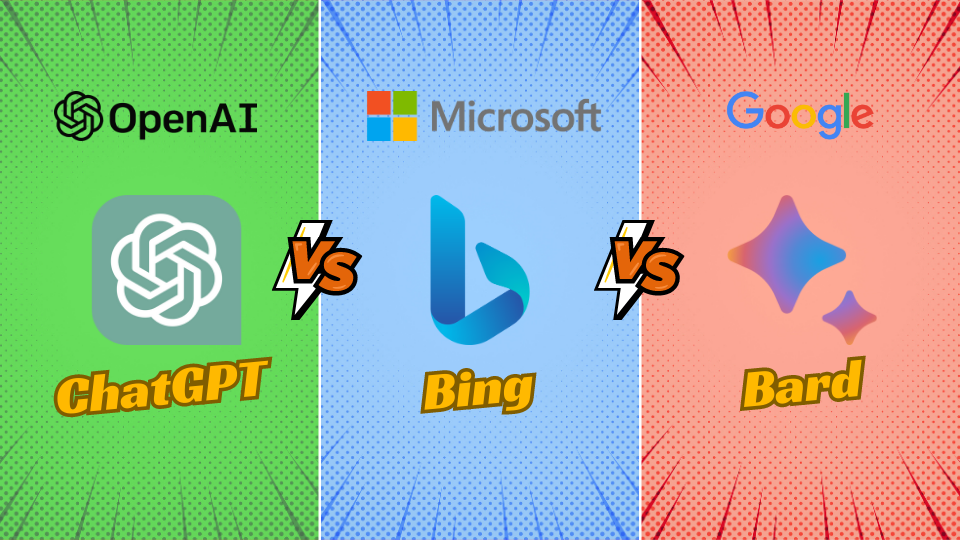AI Chatbots Step Into the Spotlight: A Detailed Examination of ChatGPT, Bing, and Bard
Stepping up as indispensable tools in the era of rapid digital transformation, AI chatbots – namely, OpenAI’s ChatGPT, Microsoft’s Bing, and Google’s Bard – are revolutionizing the realm of human-computer interaction.
These AI-powered conversationalists, utilizing complex Large Language Models (LLMs), are not just enhancing user experiences across industries but also opening new avenues of research and development in the world of Artificial Intelligence (AI). From customer service to productivity tools, their footprint is expanding, and they’re gaining traction for their multifaceted applications.
Here, we delve into an intricate analysis of these AI chatbots, unraveling their unique capabilities, recent upgrades, and how they’re shaping the future of AI.

The Promising Potential of ChatGPT
An offspring of OpenAI’s famed Generative Pretrained Transformer (GPT), ChatGPT has carved a niche for itself as a reliable and efficient conversation tool. With a choice of GPT models and plugins for Plus subscribers, it caters to a range of user requirements. The standout feature of ChatGPT is its chat-history manipulation capability, enabling users to edit, rearrange, and delete past conversations for an optimized user experience. Additionally, it possesses an impressive capability of continuing generation for potentially too-long responses that were cut short due to limitations.

Bing: Microsoft’s Intelligent Interface
As Microsoft’s answer to AI chatbots, Bing incorporates the latest GPT model into its framework, allowing users to opt between various conversation styles. Bing’s color-coded chat history stands out, offering a visually differentiated experience based on the chosen style. A significant aspect of Bing is its attempt to offer comprehensive responses by integrating infographics, links, or videos. This chatbot, however, comes with a limitation of a 20-question cap per conversation and occasional system glitches.

Bard: Google’s Experiential Experiment
Google’s Bard, presently in its experimental phase, brings to the table an array of novel features. Users can choose draft variations, edit the latest question, and use voice input, making it an interactive platform. Despite currently lacking a chat history feature, Bard scores with its capability to export conversations to other Google products like Docs, Gmail, and Google Colab.

The Bigger Picture: Understanding the AI Landscape
As we dissect these chatbots, it’s crucial to situate them within the larger AI landscape. Transformers, the underlying architecture for these chatbots, mark a significant milestone in AI, surpassing traditional machine learning by combining deep learning components. Notably, while Transformer models like Google’s Bert, Roberta, and Albert set the pace, GPT models developed by OpenAI have seen a surge in popularity.
Other chatbots like Jasper, Chatsonic, Youchat, and more, are powered by GPT’s API. Furthermore, exciting developments in AI models generating images – like Midjourney, Stable Diffusion, OpenAI’s Dall-E, Adobe’s Firefly – exemplify the broad application of this technology. We can expect more innovations from industry giants like Amazon, Nvidia, Tencent, and Alibaba in the near future.
In Conclusion: AI Chatbots at the Crossroads of Transformation
The development and growth of AI chatbots like ChatGPT, Bing, and Bard are not just reshaping the digital conversation landscape, but are a testament to the rapid advancement of AI. Each brings unique strengths to the table, and despite their limitations, they promise a realm of possibilities for businesses, users, and AI enthusiasts alike.
The use of AI chatbots is burgeoning, providing unparalleled opportunities for productivity boost, knowledge enhancement, and self-improvement. We encourage everyone to explore these tools and tap into the benefits they offer. The future of AI is here, and it’s time we embraced it.
Thank you for your continued readership. We look forward to sharing more insights and breaking developments in the AI space. Do not forget to share this piece if you find it enlightening and remember to follow us for more compelling tech news.
